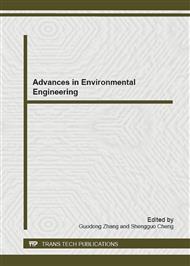p.574
p.578
p.582
p.586
p.592
p.598
p.602
p.608
p.614
On-Site Operation of a Composting-Type Eco-Toilet Using Beanstalk and Sawdust as Matrix
Abstract:
This study evaluated the feasibility of the mixed material as matrix of eco-toilet and the temporal change of pH value, T-N, T-P, T-K, organic matter and total reduction rate of dry weight in the compost. The mixed material of beanstalk and sawdust with a volume ratio of 1:1 can be used as reaction matrix of on-site composting-type eco-toilet to improve the microbial treatment of human feces. The human feces and urine could be composted to organic fertilizer rich in elements N, P and K. Change of pH in the toilet was divided two phases: changing phase (7.1-8.8) and stable phase (8.4-8.5). T-N, T-P and T-K contents increased with gradual input of feces and urine. Organic matter content decreased from 82.8% to 71.7% and the total reduction rate of dry weight increased gradually from 62.9% to 92.2%. Compost produced in the toilet could be used as organic fertilizer with the optimal concentration ratios for different plants.
Info:
Periodical:
Pages:
592-597
Citation:
Online since:
November 2012
Authors:
Keywords:
Price:
Сopyright:
© 2012 Trans Tech Publications Ltd. All Rights Reserved
Share:
Citation:


